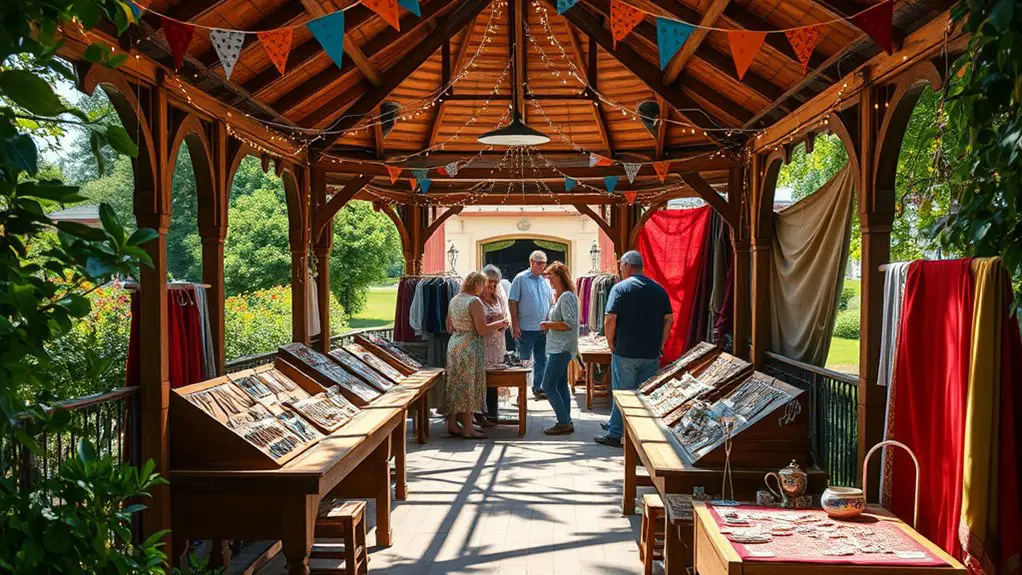Hosting a jewelry and accessories craft fair in your gazebo can be a delightful experience. Choose a date with pleasant weather, avoiding holidays for better attendance. Select local artisans for a unique touch, and design your layout to facilitate an easy flow of visitors. Promote your event through social media and vibrant flyers. Enhance the atmosphere with engaging activities like workshops and live demos. If you want to discover more tips for a successful event, keep going!
Choosing the Right Date and Time
When’s the best time to host your jewelry and accessories craft fair? Choosing the right date and time is essential for attracting attendees. Start by considering weather considerations; a sunny day can boost foot traffic, while rainy forecasts may keep people indoors. Late spring or early fall often offers pleasant weather, making them prime choices for outdoor fairs.
Next, think about potential holiday conflicts. You wouldn’t want to schedule your event on a major holiday, as many people will be busy or traveling. Instead, aim for weekends that fall in between holidays, allowing folks to enjoy your fair without distractions.
Finally, consider local events happening around the same time. You want your craft fair to shine and not compete for attention. Picking a date that complements rather than clashes with other local happenings can enhance your event’s success. Additionally, ensure your venue is equipped with hurricane-proof features to safeguard against unexpected weather changes. With careful planning, you’ll create a delightful experience for everyone involved.
Selecting Local Artisans and Vendors
When selecting local artisans and vendors for your craft fair, consider criteria like craftsmanship and originality to guarantee quality. You’re not just showcasing products; you’re promoting local talent that adds unique flair to your event. It’s also important to guarantee a diverse array of items, so visitors can enjoy a rich shopping experience.
Criteria for Selection
Although selecting local artisans and vendors for a jewelry and accessories craft fair may seem straightforward, it’s vital to establish clear criteria that guarantee a diverse and high-quality representation of talent. Start by outlining vendor qualifications such as craftsmanship, originality, and presentation. Then, create a streamlined application process to secure fairness and transparency.
Here’s a simple table to help you visualize the key criteria:
| Criteria | Description | Importance |
|---|---|---|
| Craftsmanship | Quality and skill of products | Essential for trust |
| Originality | Unique designs and concepts | Attracts customers |
| Presentation | Booth aesthetics and branding | Enhances experience |
Promoting Local Talent
Supporting local artisans and vendors not only enriches the craft fair experience but also fosters community connections and promotes regional creativity. When selecting participants, look for those who showcase unique skills and craftsmanship. This is your chance to highlight local collaborations, where artists can come together to create something truly special. Reach out to schools, community centers, and local craft groups to discover hidden gems in your area. Organize talent showcases during the event, allowing artisans to demonstrate their work live. This not only draws in attendees but also gives vendors a platform to connect with potential customers. By promoting local talent, you’re not just curating a fair; you’re building a vibrant community that celebrates creativity and craftsmanship.
Ensuring Product Variety
To guarantee an engaging experience at your craft fair, it’s essential to select a diverse range of local artisans and vendors. Start by reaching out to creators who offer unique artisan styles, from bohemian to minimalist designs. This variety not only enhances your product range but also attracts a broader audience enthusiastic for something special. Consider including vendors who specialize in different materials, like resin, metal, and textiles, to showcase the rich tapestry of local talent. Don’t forget to curate a balance between established artisans and emerging creators, as this encourages fresh ideas and creativity. By ensuring a mix of styles and products, you’ll create an inviting atmosphere that celebrates craftsmanship and sparks joy in every visitor.
Designing the Layout of Your Gazebo
When designing the layout of your gazebo, think carefully about how to allocate space for your vendors and their unique offerings. Consider arranging displays to create a natural flow that encourages visitors to explore every corner of your setup. With thoughtful strategies and creative display techniques, you can enhance the overall experience for both artisans and guests alike. Additionally, ensure that the layout allows for accessibility for all, accommodating guests with mobility issues to enjoy the event comfortably.
Space Allocation Strategies
Effective space allocation is essential for maximizing the functionality of your gazebo at the Jewelry and Accessories Craft Fair. Start by determining the ideal layout that encourages vendor flow, ensuring visitors can easily navigate through displays. Consider using vertical space for hanging jewelry or tiered stands to enhance space efficiency. Create distinct zones for different types of accessories, allowing customers to explore freely without feeling crowded. Keep pathways clear and wide enough for easy movement, avoiding bottlenecks. Use signage to guide attendees, enhancing their experience while promoting each vendor. Finally, be flexible; adjust your layout as needed throughout the event to accommodate foot traffic and maintain an inviting atmosphere. This thoughtful approach will lead to a successful craft fair in your gazebo.
Vendor Arrangement Tips
Arranging your vendors strategically can make all the difference in attracting and retaining visitors at your gazebo during the Jewelry and Accessories Craft Fair. Start by creating clear pathways for foot traffic, ensuring that booths are easily accessible. Prioritize vendor communication to understand each seller’s needs and preferences—this fosters a collaborative atmosphere. Consider booth logistics, like placing popular vendors at the entrance to draw people in and mixing accessory types to encourage browsing. Leave open spaces for seating or displays, allowing visitors to linger and engage. Don’t forget to incorporate signage for each vendor, ensuring they’re easily identifiable. A well-organized layout not only enhances the shopping experience but also promotes a sense of community among vendors and customers alike.
Display Ideas and Techniques
A enchanting display can transform your gazebo into a vibrant hub of creativity during the Jewelry and Accessories Craft Fair. Start by utilizing varied display techniques, like tiered stands or hanging displays, which draw the eye and create visual interest. Arrange your pieces in a way that tells a story—group similar items, or create themes that resonate with your audience.
Incorporate natural elements, such as plants or flowers, to enhance the visual aesthetics without overwhelming your jewelry. Use lighting to spotlight key pieces, making them pop against your backdrop. Finally, keep pathways clear to encourage free movement and exploration. With thoughtful design, your gazebo will not just showcase accessories; it’ll invite visitors to experience a delightful treasure hunt.
Promoting Your Event Effectively
When you’re gearing up to host a jewelry and accessories craft fair, promoting your event effectively can make all the difference in attracting attendees. Start by harnessing the power of social media. Create eye-catching posts that highlight unique vendors, special activities, and any giveaways. Use platforms like Instagram and Facebook to engage with your audience, encouraging them to share your event.
Don’t forget about flyer distribution! Design vibrant flyers and distribute them in local boutiques, cafes, and community centers. Consider reaching out to local influencers who can help spread the word.
Additionally, create an event page to keep everything organized and share updates. Encourage attendees to RSVP, giving you an idea of how many people to expect. Combining these strategies will amplify your reach and generate excitement, ultimately making your craft fair a memorable experience for everyone involved.
Setting Up and Decorating Your Space
Creating an inviting space for your jewelry and accessories craft fair is essential to drawing in attendees and making them feel welcome. Start by choosing a decorative theme that reflects the vibe of your creations—think bohemian, vintage, or modern chic. Use tablecloths, banners, and props that align with this theme to create a cohesive look.
Next, consider your lighting options. String lights or fairy lights can add a magical touch, while focused spotlights can highlight individual displays. Soft, warm lighting encourages a cozy atmosphere, making it easier for shoppers to browse.
Organize your space efficiently, ensuring that each vendor’s area is clearly defined yet interconnected. Don’t forget to leave room for movement; a clutter-free environment invites exploration. Finally, add personal touches like fresh flowers or handmade signs to enhance the overall experience. With thoughtful setup and decoration, you’ll create a space that feels like a celebration of creativity and freedom. Incorporating outdoor lighting options can elevate the ambiance and draw more visitors to your fair.
Engaging Activities to Enhance the Experience
Engaging activities can transform your jewelry and accessories craft fair from a simple shopping experience into an unforgettable event. Consider incorporating interactive workshops where attendees can create their own pieces, fostering creativity and connection. Live demonstrations can showcase techniques, drawing in curious shoppers and inspiring them to try their hand at crafting. Adding a shaded area will enhance comfort for both vendors and attendees, making the experience more enjoyable.
Here’s a quick overview of engaging activities you might include:
| Activity Type | Description |
|---|---|
| Interactive Workshops | Hands-on sessions for creating jewelry |
| Live Demonstrations | Expert artisans showcasing techniques |
| DIY Stations | Set up stations with supplies for quick crafts |
These activities not only enhance the experience but also encourage visitors to linger longer, fostering a vibrant atmosphere. So, embrace these ideas and watch your craft fair come alive with creativity and excitement!
Tips for a Successful Event Day
To guarantee a successful event day, planning ahead is essential, as it sets the tone for a smooth and enjoyable experience for all attendees. Start by finalizing your event logistics well in advance; make certain vendors know their setup times and space requirements. Create a checklist for everything from tables to trash bins, and keep it visible.
Volunteer coordination is vital; assign specific roles and tasks to your helpers. Make sure they’re well-briefed on their responsibilities, so they can assist vendors and attendees seamlessly. Consider a briefing session before the event kicks off to address questions and set expectations.
Don’t forget to have a clear schedule for activities and demonstrations, allowing for flexibility. Keep communication open throughout the day, using walkie-talkies or a group chat for real-time updates. Additionally, ensure your gazebo is equipped with mosquito netting to enhance the comfort of your attendees. Finally, have fun! Your enthusiasm will resonate with everyone and create a welcoming atmosphere.
Frequently Asked Questions
What Permits Do I Need for Hosting a Craft Fair?
You’ve got a great idea, but don’t forget about the details! Check vendor registration requirements and local regulations; they’re essential for a smooth event. It’s your chance to share creativity without any hiccups!
How Can I Ensure Safety and Accessibility for Attendees?
To guarantee safety and accessibility, plan attendee flow carefully, creating clear pathways. Develop an emergency plan detailing exits and procedures. Regularly communicate these measures, so everyone feels secure and free to enjoy the event.
What Is the Best Way to Handle Vendor Payments?
To handle vendor payments effectively, establish clear payment methods in your vendor contracts. Consider options like digital payments or checks, ensuring all terms are transparent. This way, you foster trust and maintain smooth transactions throughout the event.
How Do I Manage Weather-Related Issues During the Event?
To manage weather-related issues, create a weather contingency plan. If necessary, communicate potential event rescheduling to vendors and attendees promptly. Keeping everyone informed guarantees a smooth shift, allowing you to maintain a positive atmosphere despite unforeseen circumstances.
What Insurance Coverage Do I Need for the Event?
For your event, you’ll need liability insurance to protect against accidents and injuries. Additionally, consider event coverage to safeguard against cancellations or unforeseen issues. This way, you can focus on enjoying the day without worries.

